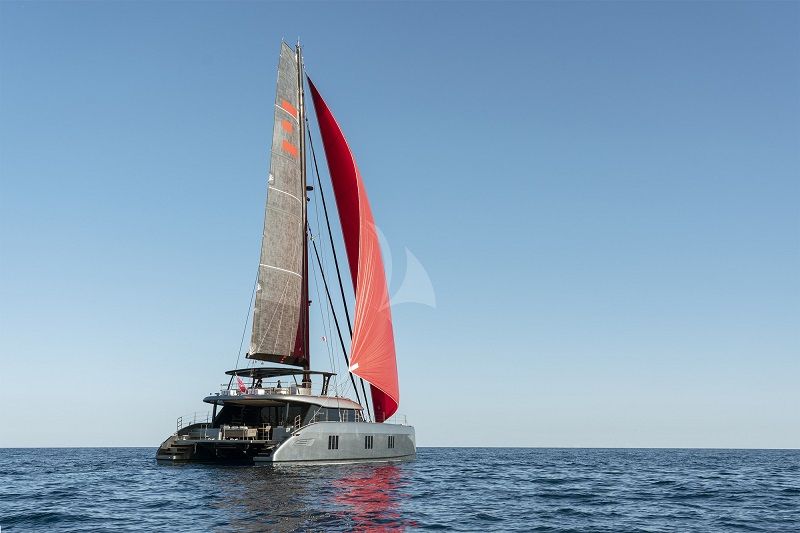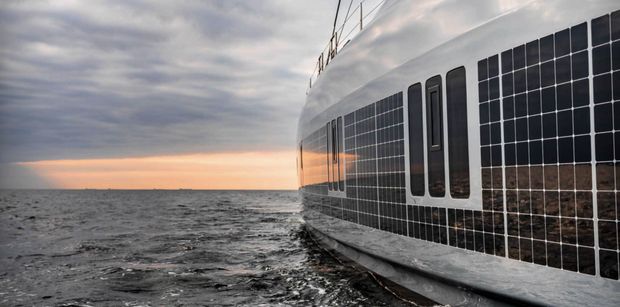The catamaran fleet has long been admired for its stability, speed, and versatility with its unique multi-hull design. Today they are also hailed as being more sustainable than the conventional monohull.
With so many builders in the industry pushing the boundaries on the multi-hull scene, a new wave of sustainable concepts is revolutionizing the industry.
As soon as these concepts hit the water, we will offer them for charter on Boatbookings – check for them on our crewed charter catamarans.

Design elements: electrification, new materials, energy efficiency
There are various factors that designers now take into account when launching new catamaran concepts and designs, with sustainability seemingly at the forefront.
- Electric propulsion: Transitioning from conventional fuel-powered engines to electric propulsion systems is a significant step in sustainability. Electric motors offer zero-emission operation, minimizing both air and water pollution. In addition to this, there have been advancements in battery technology to increase the range and efficiency. Scroll down to take more of a read on electric yachting in our previous post.
Oh, and they don’t stink of noxious fumes when you’re swimming near them! - Lightweight and eco-friendly materials: Utilising lightweight and eco-friendly materials reduces the catamaran’s weight and enables enhanced fuel efficiency and reduced emissions. Flax fiber composites are one such material. Flax is a fibrous plant that for centuries has provided the basis for linen, and can be used instead of glass fiber. It is lighter than glass and requires 2-5 times less energy to produce.
- Energy-efficiency: Catamaran design is now being optimized for reduced energy consumption. Through smart energy management systems, advanced multi-hull designs to reduce drag, and other factors such as LED lighting and the use of solar panels.

Cool Cat Examples:
We already have a range of electric crewed catamarans for you to choose from that are currently on the water, but below are some new concepts that have not yet splashed onto the charter market. We are very excited to see how these catamarans develop.
Alva yachts and their wings
Alva Yachts has recently announced that the second yacht in its flagship 28-meter Ocean Eco 90 catamaran series has begun construction. The Ocean Eco 90 has a fully electric drive and hydrogen fuel cell. It will be powered by two performance electric motors connected to a 500 kWh battery pack, with power from solar panels. It will also be fitted with Gyro’s Oceanwings wind propulsion system.
A Hybrid Launch by Rossinavi
The Italian shipyard unveiled a new catamaran concept in collaboration with Zaha Hadid Architects, called Oneiric. The 44-meter eco-friendly vessel has solar energy at its core with four modes of operation. The hybrid concept can be fully-electric for day trips and adjusted for multi-day cruises. Its transatlantic range can be 80% electric and in ‘hibernation’ mode to allow it to be self-sufficient when in port.

The Domus concept
At over 40 meters long, this radical concept was designed by Van Geest Design and Rob Doyle Design. The Domus concept claims to be the first truly zero-emissions yacht over 750 gross tonnes. The design is supported by hydrogen fuel cells, hydrogenation, and solar energy. It also boasts an unlimited range. We can’t wait until these designs are the norm.
ModX
Although on a smaller scale, these catamarans are nonetheless impressive. This 100% electric and renewable energy-driven catamaran is being launched this October. With a sleek and futuristic design, Mod X focuses on sustainability and efficiency, incorporating lightweight materials and eco-friendly systems.
These concepts are only a few of the new designs being announced daily. Highlighting the fact that catamaran design harnesses innovative technologies, materials, and design principles to minimize their environmental impact and carbon emissions without compromising on performance and luxury. Contact the Boatbookings team if you want to be part of leading the change on green chartering today.



